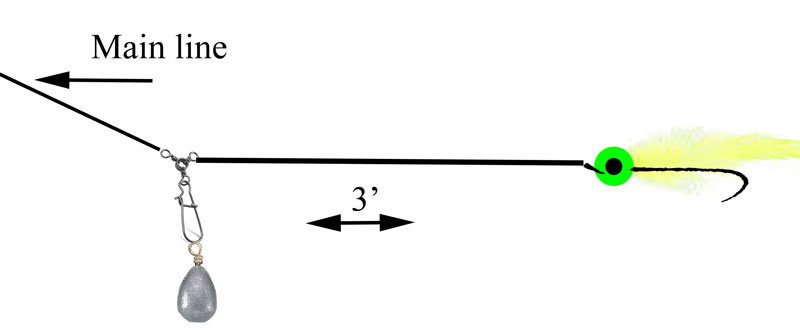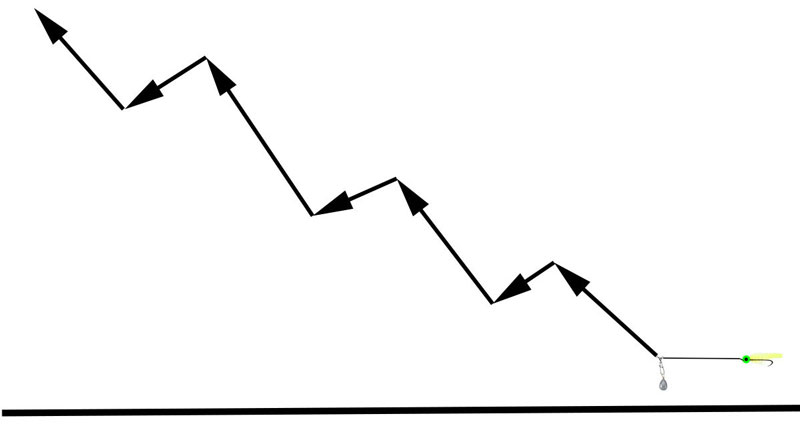The email from David made my jaw drop: had we ever done an article on feather jigging for striped bass? Well, shoot — nope! Now in our seventh year of publication, with over 500 how-to/where-to fishing features in the history books (and online for your perusal here at the website), somehow, we’ve managed to completely omit feather jigging from the library. OOPS!

In our own defense, not nearly as many people apply the feather jigging tactic these days as they did a few decades ago. Back in the 90s it was more or less the hot thing, and if a dozen boats were fishing around the Bay Bridge rockpiles 10 of them would be tossing feather jigs. Today, it would be surprising if one was. Why? Certainly not because feather jigging stopped working. It’s just as effective today as it ever was. But we anglers are a fickle bunch, moving from one hot lure to the next in our never-ending search to catch more, bigger fish. So, many anglers won’t have heard about this tactic and very few beginners will be familiar with it. In fact, it’s a fair bet that there’s an entire generation of anglers out there who have never tried feather jigging.
That’s a shame, because there are two scenarios in which it may well out-produce whatever else you decide to try. The first is when fish are suspending in relatively deep water and it’s tough to get a lure right in front of them. Whether the fish are constantly on the move or wind and current make it difficult to control lure depth, feather jigging is an ideal move because the presentation goes from the bottom right up to the surface. The second is when rockfish are widely scattered along a tributary channel edge in 15’ to 20’ of water, making it difficult to target them without trolling.
Feather Jig Rigging
The stock-and-trade feather jig rig is a three- or four-inch, quarter- or half-ounce feather jig (the kind with a little “popeye” head and chicken feathers tied onto the hook) in chartreuse, yellow, or white, tied to a three-foot leader of 20-pound test. At the other end of the leader tie on a triple-swivel with a dropper clip on the extra swivel eye. Then, clip on a one- to two-ounce dipsy sinker (depending on the depth; an ounce is good to 20 or 25 feet and upsize for deeper water).

Match this rig up with a 12- or 15-pound class rod that has a slow-action tip, mono line on the reel, or both. The motion you’re about to impart using the feather jigging rig requires gear that will absorb slack and give a bit as force is applied and released. You can certainly catch fish using this tactic with braid and fast action, but you’ll find it extremely difficult to keep momentary slack out of the line and will suffer from some missed strikes and tip-wraps as a result.
How to Fish With a Feather Jig
Once you’re rigged and ready, cast out as far as possible, and allow the rig to sink until it’s sitting on bottom. Then take in slack line, sweep the rod tip up, and then allow it to fall as you crank on the reel. Crank quickly enough to bring in some line as well as maintaining tension while dropping the rod tip. As soon as the tip is parallel with the water’s surface, sweep it up again. Continue retrieving in this fashion with long, slow sweeps of the rod tip, and never stop cranking the reel. The idea is to make the lure move up through the water column as it’s retrieved with a zigzag that goes up and down, instead of sideways.
The key to effective feather jigging has everything to do with rhythm. Should you be reeling at a pace that allows the lure to sink back down two feet after darting upwards, while traveling five feet forward? Or do you need to slow things up and get a five-foot fall while moving two feet forward? Who knows—this is entirely up to the fish. You need to vary your rhythm until getting a strike, then try to repeat what works. If the fish stop biting, change things up again. Every tidal cycle can be different but once you identify the pump-and-crank rhythm that gets them snapping, you can catch one fish after the next.

Trolling Feather Jigs
This same rig is deadly when fish are scattered along channel edges in the tributary rivers but in this case instead of casting, slow-troll it at just a couple of mph. Let out enough line that the rig reaches bottom, sweep the tip forward, then let it drop back while maintaining tension. After a few sweeps let out some more line and find bottom again. Depending on the conditions and the size of your weight you may need to let out line several more times, until you can reliably feel the weight touch down as you drop it back. Set the rod in a holder and you’ll drastically reduce your chances of getting a strike — the fish will want to see that feather jig darting and falling, darting and falling.
Ready to give feather jigging a shot? Your biggest problem now will probably be finding some traditional Chesapeake Bay feather jigs. There are similar offerings to be found online but the real deal is only available at a well-stocked, local-minded tackle shop. Find some and give it a shot, however, and there’s a good chance you’ll have a slot rock in the cooler before you know it. And if you happen to see David after catching those fish, be sure to thank him for sending that email.